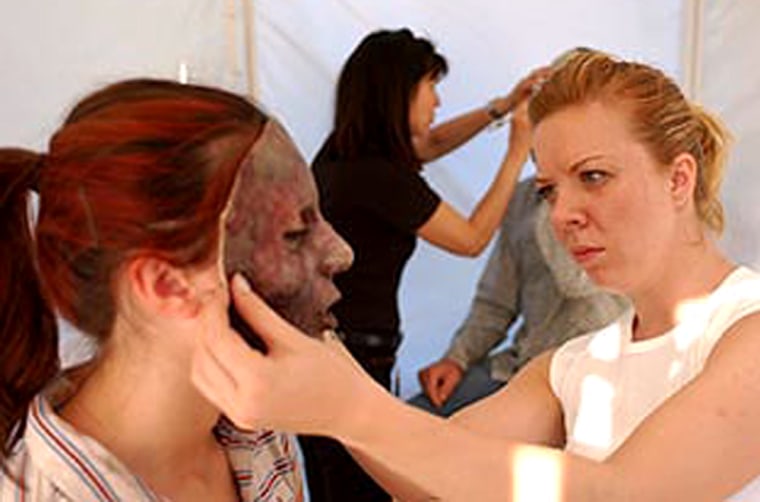There's an old saying that, when driving past a graveyard, you should hold your breath, because "it's not polite to breathe in front of people who cannot." Silly, sure, but there's a message in it: Respect the dead.
Hollywood adds a caveat to that thought: Respect the dead, or they may eat your brains.
Forget vampires, werewolves, mummies or the more individualized monsters, like King Kong or Godzilla. To me, the best, the scariest, the ultimate monster-movie monster is, and will always be: The zombie.
I'm not talking about Haitian zombies, here. Rather these are the Hollywood zombies that became popular in 1968, with George Romero's landmark "Night of the Living Dead," its sequels, "Day of the Dead" and "Dawn of the Dead," and the new "George Romero's Land of the Dead."
Similar zombies have made classic appearances in films such as "Return of the Living Dead," "Pet Sematary," and "28 Days Later." Zombies are common on TV too, with appearances on "South Park" and "The Simpsons" and even in Michael Jackson's "Thriller" video. And I can't ignore the hilarious zombie comedy, "Shaun of the Dead," which proves that even the living dead need not always be taken seriously.
If you've seen any of the above, you know what zombies are. They're us, or rather, our beloved dead. And that's part of what makes these movies so irresistible to their fans. In the horror universe, it's relatively easy to stake a vampire, burn Frankenstein's monster, or shoot a silver bullet into a werewolf. They're monsters! Anonymous monsters who would as soon kill you as look at you! Kill 'em all, let God sort it out!
But zombies? They're monsters now, sure, but they're monsters we recognize. Mom, wearing her familiar housedress, or your spouse, or even your child, dressed in the play clothes you made him. Sometimes they appear to snap out of their zombie state and seem to come back to us as the people we lost. Many a would-be zombie-killer has faltered and ended up as lunch because of it.
There's a chilling scene in 1985's "Return of the Living Dead" where a woman named Tina has fled from the flesh-munching zombies and is hiding in the attic of a funeral home. Her boyfriend, zombified Freddy, is on the floor right below her, banging on the ceiling for her to let him in. His voice swings between Zombie Freddy and Boyfriend Freddy, and is never more unnerving than when he says sweetly "I love you Tina, and that's why you need to let me EAT YOUR BRAINS."
Brain power
The movie zombie has evolved. They weren't always hungry for brain food. Back in "Night of the Living Dead" Romero called them "marauding ghouls," and they weren't picky about their dinner — they'd eat any part of you. Instead you were supposed to go after their brains. As one character explained "since the brain of a ghoul has been activated by the radiation, the plan is kill the brain, and you kill the ghoul."

Nearly 20 years after Romero's ghouls roamed the land, an unrelated film called "Return of the Living Dead" came out. When the characters stir up the living dead once again, they reach back to their memories of the Romero movie to figure out how to deal with them. But when they try striking at the zombies' brains, the zombie keeps coming. ("It worked in the movie!" wails one human.)
In the "Return of the Living Dead" universe, as they eventually learn, even cutting a creature into pieces just results in a heap of living, quivering pieces. It's not until after a lot of trial and error that they figure out: This time, the zombies are after the brains of the living. One creature confesses that it's the only thing that makes the pain of dying go away.
"Dawn of the Dead," the second zombie movie in Romero's trilogy, recently was remade with a new cast. A majority of the film is set at a shopping mall, and survivors realize that zombies are gathering at the mall out of some faint, but pleasant, memory.
Once again, we're reminded that the zombies are not completely monsters. They're trapped between our world and theirs, still clinging to some memories and instincts. Some still wear the uniforms of their work worlds (the excellent singles out the zombie nurse).
Those few humans who are not yet zombies have to deal not only with survival, but with the fact that the world they have always known, our world, is forever changed. It still looks the same — the mall still stands, its stores still full of products — but now money is useless and TVs and radios only play static.
Zombie movies work on the same level as movies set after nuclear war — everything is familiar, everyone is familiar, but the world is forever changed. Those who survive are those who are willing to literally murder their memories, and by doing so, throw out everything they've ever known and start over from scratch.
It's a very important American concept, this ability to make your way in a rough new land, with new problems threatening you at every turn.
Perhaps that's part of why these movies have been so popular — we'll always identify with those who are able to successfully bury their past and adapt to a new harsh world. Scarlett O'Hara, she who was able to pick herself up and reinvent herself after the South was devastated in the Civil War, would have survived the zombies.
Ashley Hamilton? Would have been lunch.
Gael Fashingbauer Cooper is MSNBC's TV and Books editor.